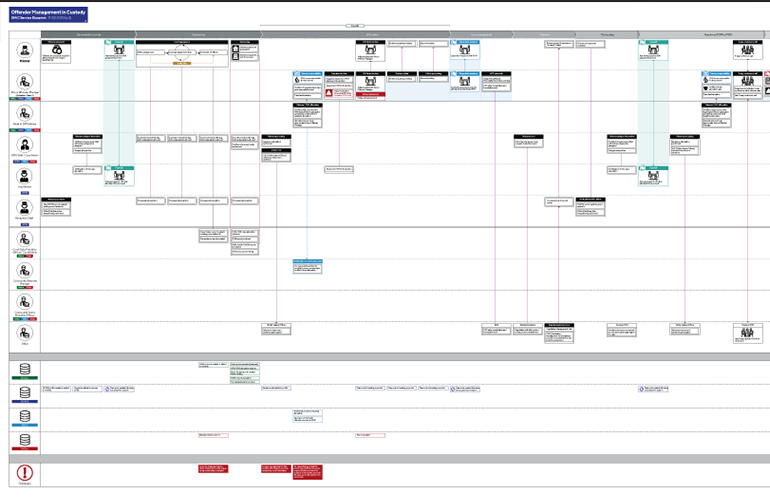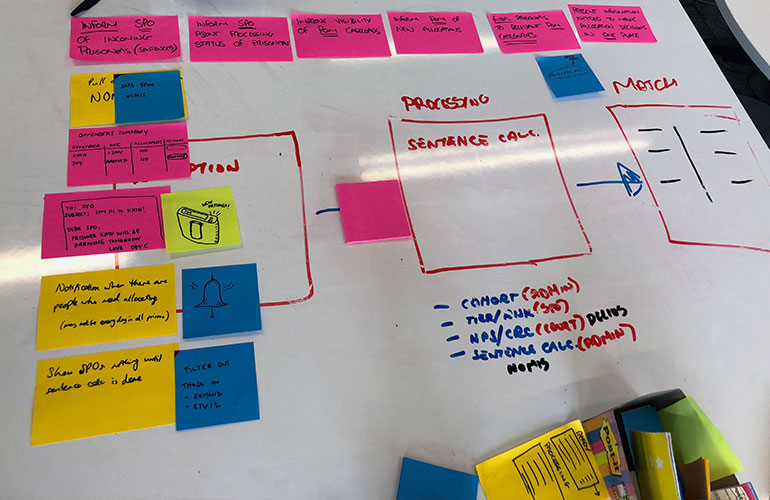Offender Management in Custody
Duration: 12 months | Role: Service Designer / Interaction Designer

Introduction
Offender Management in Custody is a new policy that spans both the Prison Service and Probation Service within England and Wales. The roll out begins in Wales in January 2019 and England in September 2019.
This project was to support those based within both custody and the community adapting to these policy changes as well influence the policy intent. At the centre of this policy was to further enhance the long term chances of prisoner rehabilitation by bringing offender interventions and case management from the community to within the prison.

My Role
My role within this project spanned both service design and interaction design. It was necessary to cover both roles in order to deliver and shape policy intent as well as multiple digital services.
These services being used both across the prison estate in England and Wales, but also within community based probation offices.

Design as a Team Sport
One of the greatest challenges of any multifunctional team is finding the right balance between collaboration and working in isolation. As the service designer on the team, I was keen to ensure that all members of the wider team were engaged with creating solutions to the problems that new policy brings.
With the help of user research, it was possible to overlay our new service blueprint over the current method offender management. This allowed us to expose all the potential problem areas, place these issues into a series of hypothesis statements and then design solutions in order to address these issues. By using hypothesis statements, this allowed us to measure the impact of our solutions and to determine if these were successful or not rather than user feedback soundbites.

Collaborating with Policy Writers
Working closely with key stakeholders at the same time as the policy was being written allowed us to collaborate and shape a service blueprint. This was ideal as instead of using policy as a set of fixed requirements we was able to design policy intent together based on a deeper understanding of our users and the challenges they face.
By doing this, it was possible to take a more iterative and ‘user-centred’ approach to service design in an area that has many complexities and issues that have far reaching risks attached.

Standardising Design Patterns
With such a large design team working on multiple services intended to make the lives of both citizens and staff easier, it is often difficult to keep interaction patterns consistent. Especially as many of those designers are working on long existing and successful services with a user base now very familiar with how to complete very complex tasks.
When designing new services, this presents an opportunity to collaborate on consistent approaches to design solutions, especially for our staff members who interact with multiple services delivered by multiple cross functional teams from across many differing locations. Where the GDS Design System is the basis of all interaction languages used, it often lacks guidance when it comes to staff facing services.

Sketching Interactions
As part of a design process that includes HTML prototypes, I was keen to ensure that the team adapt a ‘fail fast, fail early’ approach to design solutions. This would almost always start with sketching the interactions on paper, Post-Its and / or whiteboards. The challenge of committing too early to hi-fidelity mock ups (such as Sketch designs or HTML prototypes) is that it is often quite difficult to accept they may not be the most appropriate solutions to the problem that is being addressed. Once we have confidence in a single design approach, we then look to increase the fidelity of the solution.

Validating the Value Proposition
To ensure that the Service Blueprint created is to deliver on policy intent, it was hugely important that we validated the value proposition with each of the user types. By following a user-centred approach it helps further our chances of our service working as intended.
This meant spending a great deal of time working with those based in prisons and community based probation offices to validate our thinking. These research sessions were not limited to just prototype testing (on paper, PDF and HTML prototypes) but also to other forms of user validation, such as workshops, focus groups and card sorting.